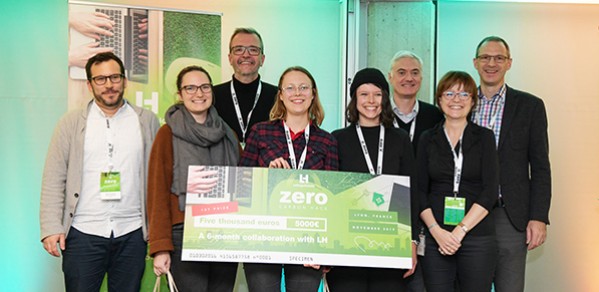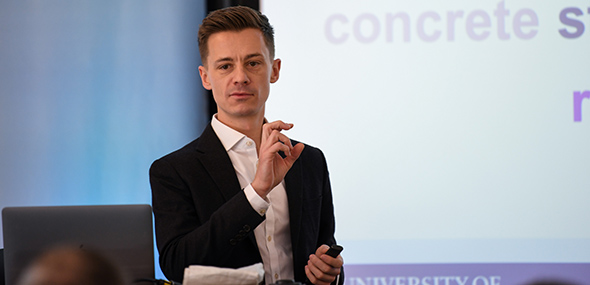
Cambridge PhD students joined their peers from 10 European countries to participate in a ‘Zero Carbon Hackathon’ set up to find ways to tackle carbon emissions from cement manufacture.
Tackling carbon emissions from cement manufacture is a key challenge for construction. The hackathon has demonstrated that reducing embodied carbon is feasible, even with relatively modest interventions.
Dr John Orr
Held across a weekend at the global LafargeHolcim Innovation Centre, in France, the students, together with a dozen mentors, examined a reference building – a real residential building design proposed for construction in Switzerland – and dreamt up new ways to minimise embodied carbon (all the CO2 emitted as a result of producing materials for the building).
Dr John Orr, Lecturer in Concrete Structures, gave a short lecture as part of the weekend, explaining why he believes up to 50% less material could be used in construction thanks to better design. Dr Orr highlighted how using less material and avoiding errors in construction (that account for about one fifth of the material being wasted) can reduce carbon and make a real difference.
The students were split into interdisciplinary teams and asked to come up with proposals that demonstrated how embodied carbon can be reduced in concrete construction.

Dr John Orr during his lecture at the Zero Carbon Hackathon. Credit: LafargeHolcim.
Cambridge PhD students Ellie Marsh and Jess Forsdyke were part of the winning team whose approach involved the introduction of LC3 cement – a low carbon binder alternative to Portland cement, the most common type of cement in general use around the world – and the replacement of flat slab construction that makes use of expensive materials, with a lightweight thin-shell vault system. In addition, they proposed a novel on-site prefabrication method using sand moulds and robotic construction to minimise transport and enable mass production of the vault system.
The team’s approach to structural systems and material selection cut CO2 emissions by 45% compared to the reference building, and they were awarded €5000 and six months’ worth of development work with Lafarge to extend their ideas.
Dr Orr said: “We had four Cambridge PhD students – Ellie Marsh, Jess Forsdyke, Florence Maskell and Mar Giménez Fernández – join the hackathon, which I have been working on with the LafargeHolcim Foundation. The winning team’s idea was commended by the judges for an approach of optimising and reducing material use to achieve significant reductions in embodied carbon.
“Tackling carbon emissions from cement manufacture is a key challenge for construction. The hackathon has demonstrated that reducing embodied carbon is feasible, even with relatively modest interventions. In addition to tackling the technical design and learning about whole-life carbon, the event was an excellent networking opportunity.”
PhD student Jess Forsdyke said: "The hackathon was a great opportunity to explore what current practice in design geometries, material selection and innovative concrete technologies enables us to do as engineers to minimise embodied CO2. Working alongside other disciplines, such as architects and business specialists, also gave insight into the challenges faced by the various stakeholders in a real design scenario."
PhD student Ellie Marsh added: "The hackathon was well organised and the various mentors were really helpful throughout the weekend. It was a great opportunity to meet and collaborate with other researchers in the area of sustainable concrete. There was also a guided tour of the Lafarge research laboratories which was a particularly valuable highlight.”
LafargeHolcim Awards competition
The competition has a Next Generation category for young professionals and students up to 30 years of age. This category seeks visionary design concepts and bold ideas at a preliminary stage of design, including design studio and research work. The competition is open for entries until February 25, 2020. Participation is free and prize money totals $2 million.
This article has been edited from the LafargeHolcim Foundation website.

